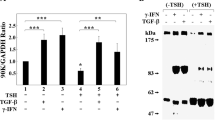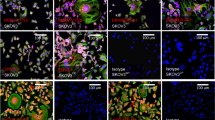Abstract
We previously demonstrated that restoration of TP53 activity in anaplastic thyroid carcinoma inhibits cell growth and induces expression of thyroid differentiation markers. Here, we investigated whether TP53 status may condition the expression of therapeutic genes driven by retroviral LTR or tissue-specific enhancer elements. The TP53-defective ARO anaplastic thyroid carcinoma cells were transfected with TP53Val135, which exhibits wild-type activity at 32°C, and transduced with retroviral vectors, in which therapeutic genes were driven either by wild-type LTR or by a reshuffled LTR containing thyroglobulin (TG) enhancer. Both at 37 and 32°C, expression of transgenes driven by TG enhancer was 10-fold lower than that obtained with wild-type LTR retroviral vector. TP53Val135 transfer into ARO cells repressed transcription from wild-type LTR but increased expression of TG-driven therapeutic genes. This effect was markedly enhanced by cell culture at 32°C and by TSH treatment. Cytotoxic effects shown after ganciclovir treatment paralleled therapeutic gene expression levels. In conclusion, TP53 status in the tumor cell can influence expression of therapeutic genes. When using retroviral-vector-based gene therapy, wild-type LTR vectors should be employed to target TP53-defective tumors, whereas thyroid-specific promoters should be used for transcriptional targeting of thyroid carcinomas carrying wild-type TP53.
This is a preview of subscription content, access via your institution
Access options
Subscribe to this journal
Receive 12 print issues and online access
$259.00 per year
only $21.58 per issue
Buy this article
- Purchase on Springer Link
- Instant access to full article PDF
Prices may be subject to local taxes which are calculated during checkout


Similar content being viewed by others
References
Barzon L, Pacenti M, Boscaro M, Palù G . Gene therapy for thyroid cancer. Expert Opin Biol Ther. 2004;4:1225–1239.
Barzon L, Bonaguro R, Castagliuolo I, et al. Gene therapy of thyroid cancer via retrovirally-driven combined expression of human interleukin-2 and herpes simplex virus thymidine kinase. Eur J Endocrinol. 2003;148:73–80.
Barzon L, Bonaguro R, Castagliuolo I, et al. Transcriptionally targeted retroviral vector for combined suicide and immunomodulating gene therapy of thyroid cancer. J Clin Endocrinol Metab. 2002;87:5304–5311.
Shimura H, Suzuki H, Miyazaki A, et al. Transcriptional activation of the thyroglobulin promoter directing suicide gene expression by Thyroid Transcription Factor-1 in thyroid cancer cells. Cancer Res. 2001;61:3640–3646.
Kitazono M, Chuman Y, Aikou T, Fojo T . Adenovirus HSV-TK construct with thyroid-specific promoter: enhancement of activity and specificity with histone deacetylase inhibitors and agents modulating the camp pathway. Int J Cancer. 2002;99:453–459.
Moretti F, Farsetti A, Soddu S, et al. p53 re-expression inhibits proliferation and restores differentiation of human thyroid anaplastic carcinoma cells. Oncogene. 1997;14:729–740.
Fagin JA, Matsuo K, Karmakar A, Chen DL, Tang SH, Koeffler HP . High prevalence of mutations of the p53 gene in poorly differentiated human thyroid carcinomas. J Clin Invest. 1993;91:179–184.
Ginsberg D, Michael-Michalovitz D, Ginsberg D, Oren M . Induction of growth arrest by a temperature-sensitive p53 mutant is correlated with increased nuclear localization and decreased stability of the protein. Mol Cell Biol. 1991;11:582–585.
Palù G, Pizzato M, Bonaguro R, Colombo F . Gene therapy of glioblastoma multiforme with bicistronic retroviral vector expressing human IL-2 and HSV-TK. In: Walther W, Stein U, eds. Methods in Molecular Medicine, Vol 35: Gene Therapy: Methods and Protocols. Totowa, NJ: Humana Press, Inc.; 2000: 505–516.
Battista S, Martelli ML, Fedele M, et al. A mutated p53 gene alters thyroid cell differentiation. Oncogene. 1995;11:2029–2037.
Casamassimi A, Miano MG, Porcellini A, et al. p53 genes mutated in the DNA binding site or at a specific COOH-terminal site exert divergent effects on thyroid cell growth and differentiation. Cancer Res. 1998;58:2888–2894.
Fagin JA, Tang SH, Zeki K, Di Lauro R, Fusco A, Gonsky R . Reexpression of thyroid peroxidase in a derivative of an undifferentiated thyroid carcinoma cell line by introduction of wild-type p53. Cancer Res. 1996;56:765–771.
Zeki K, Tanaka Y, Morimoto I, et al. Induction of expression of MHC-class-II antigen on human thyroid carcinoma by wild-type p53. Int J Cancer. 1998;75:391–395.
Moretti F, Nanni S, Farsetti A, et al. Effects of exogenous p53 transduction in thyroid tumor cells with different p53 status. J Clin Endocrinol Metab. 2000;85:302–308.
Narimatsu M, Nagayama Y, Akino K, et al. Therapeutic usefulness of wild-type p53 gene introduction in a p53-null anaplastic thyroid carcinoma cell line. J Clin Endocrinol Metab. 1998;83:3668–3672.
Imanishi R, Ohtsuru A, Iwamatsu M, et al. A histone deacetylase inhibitor enhances killing of undifferentiated thyroid carcinoma cells by p53 gene therapy. J Clin Endocrinol Metab. 2002;87:4821–4824.
Kim SB, Ahn IM, Park HJ, et al. Growth inhibition and chemosensitivity of poorly differentiated human thyroid cancer cell line (NPA) transfected with p53 gene. Head Neck. 2001;23:223–229.
Nagayama Y, Yokoi H, Takeda K, et al. Adenovirus-mediated tumor suppressor p53 gene therapy for anaplastic thyroid carcinoma in vitro and in vivo. J Clin Endocrinol Metab. 2000;85:4081–4086.
Martinez J, Georgoff I, Martinez J, Levine AJ . Cellular localization and cell cycle regulation by a temperature-sensitive p53 protein. Genes Dev. 1991;5:151–159.
Deb S, Jackson CT, Subler MA, Martin DW . Modulation of cellular and viral promoters by mutant human p53 proteins found in tumor cells. J Virol. 1992;66:6164–6170.
Subler MA, Martin DW, Deb S . Inhibition of viral and cellular promoters by human wild-type p53. J Virol. 1992;66:4757–4762.
Jackson P, Bos E, Braithwaite AW . Wild-type mouse p53 down-regulates transcription from different virus enhancer/promoters. Oncogene. 1993;8:589–597.
Subler MA, Martin DW, Deb S . Activation of the human immunodeficiency virus type 1 long terminal repeat by transforming mutants of human p53. J Virol. 1994;68:103–110.
Chicas A, Molina P, Bargonetti J . Mutant p53 forms a complex with Sp1 on HIV-LTR DNA. Biochem Biophys Res Commun. 2000;279:383–390.
Ginsberg D, Mechta F, Yaniv M, Oren M . Wild-type p53 can down-modulate the activity of various promoters. Proc Natl Acad Sci USA. 1991;88:9979–9983.
Berg V, Vassart G, Christophe D . Identification of a thyroid-specific and cAMP-responsive enhancer in the upstream sequences of the human thyroglobulin promoter. Biochim Biophys Acta. 1996;1307:35–38.
Acknowledgements
This work was supported by Grants from MIUR (Ministero dell'Istruzione, dell'Università e della Ricerca) No. 2001061979 and 2002062741.
Author information
Authors and Affiliations
Corresponding author
Rights and permissions
About this article
Cite this article
Barzon, L., Gnatta, E., Castagliuolo, I. et al. Modulation of retrovirally driven therapeutic genes by mutant TP53 in anaplastic thyroid carcinoma. Cancer Gene Ther 12, 381–388 (2005). https://doi.org/10.1038/sj.cgt.7700789
Received:
Published:
Issue Date:
DOI: https://doi.org/10.1038/sj.cgt.7700789
Keywords
This article is cited by
-
Terapia genica dei tumori endocrini: attualità e prospettive
L'Endocrinologo (2006)



